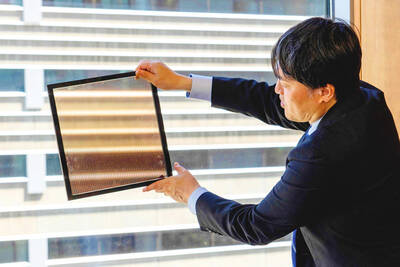Local electronics maker Wistron Co (緯創) said yesterday it would spend NT$9.2 billion (US$303 million) in cash to buy a liquid-crystal-display (LCD) monitor unit from Lite-On Technology Corp (光寶科技) to boost its sales and competitiveness.
Wistron would acquire Lite-On’s manufacturing equipment, inventory and patents, as well as employees, a company statement said.
The deal “will complete Wistron’s LCD monitor product line and increase the product’s business,” Wistron said.
Following the acquisition, Wistron would be in a better position to offer more competitive prices, paving the way for a next wave of technological cooperation, it said.
Lite-On’s LCD monitor unit generated NT$83 billion in revenues last year.
The transaction is scheduled to be completed in the third quarter.
In addition, Wistron said that it would sell a maximum of 24 million common shares.
The acquisition and new share offering will be discussed during an annual shareholder meeting on June 25.
To fund purchase of raw materials overseas, Wistron will also offer a maximum of 300 million common shares in the form of global depositary receipts.
Wistron said yesterday that its first-quarter net income rose 53 percent year-on-year to NT$1.68 billion, compared with NT$1.1 billion a year ago.

UNCERTAINTIES: Exports surged 34.1% and private investment grew 7.03% to outpace expectations in the first half, although US tariffs could stall momentum The Chung-Hua Institution for Economic Research (CIER, 中華經濟研究院) yesterday raised its GDP growth forecast to 3.05 percent this year on a robust first-half performance, but warned that US tariff threats and external uncertainty could stall momentum in the second half of the year. “The first half proved exceptionally strong, allowing room for optimism,” CIER president Lien Hsien-ming (連賢明) said. “But the growth momentum may slow moving forward due to US tariffs.” The tariff threat poses definite downside risks, although the scale of the impact remains unclear given the unpredictability of US President Donald Trump’s policies, Lien said. Despite the headwinds, Taiwan is likely

When Lika Megreladze was a child, life in her native western Georgian region of Guria revolved around tea. Her mother worked for decades as a scientist at the Soviet Union’s Institute of Tea and Subtropical Crops in the village of Anaseuli, Georgia, perfecting cultivation methods for a Georgian tea industry that supplied the bulk of the vast communist state’s brews. “When I was a child, this was only my mum’s workplace. Only later I realized that it was something big,” she said. Now, the institute lies abandoned. Yellowed papers are strewn around its decaying corridors, and a statue of Soviet founder Vladimir Lenin

UNIFYING OPPOSITION: Numerous companies have registered complaints over the potential levies, bringing together rival automakers in voicing their reservations US President Donald Trump is readying plans for industry-specific tariffs to kick in alongside his country-by-country duties in two weeks, ramping up his push to reshape the US’ standing in the global trading system by penalizing purchases from abroad. Administration officials could release details of Trump’s planned 50 percent duty on copper in the days before they are set to take effect on Friday next week, a person familiar with the matter said. That is the same date Trump’s “reciprocal” levies on products from more than 100 nations are slated to begin. Trump on Tuesday said that he is likely to impose tariffs

Japan is heavily investing in a new kind of ultra-thin, flexible solar panel that it hopes will help it meet renewable energy goals while challenging China’s dominance of the sector. Pliable perovskite panels are perfect for mountainous Japan, with its shortage of flat plots for traditional solar farms. A key component of the panels is iodine, something Japan produces more of than any country but Chile. The push faces some obstacles: Perovskite panels contain toxic lead, and, for now, produce less power and have shorter lifespans than their silicon counterparts. Still, with a goal of net zero by 2050 and a desire to